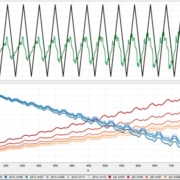pH Controlled Electrochemical Deposition of Polyelectrolyte Complex Films
Authors: Kazi Sadman, Qifeng Wang, Shawn H Chen, David Efim Delgado and Kenneth R Shull. Northwestern University, Evanston, Illinois, US
Journal: Langmuir 2017, 33(8) 1834-1844.
Abstract: Polyelectrolyte complex (PEC) films made from oppositely charged polymer chains have applications as drug delivery vehicles, separation membranes, and biocompatible coatings. Conventional layer-by-layer (LbL) techniques for polyelectrolyte coatings are low-throughput and multistep processes that are quite slow for building films on the order of micrometers. In this work, PEC films are electrochemically deposited using a rapid one-pot method yielding thick (1 μm) films within short experimental time scales (5 min). This rapid electrodeposition is achieved by exploiting the reduction of hydrogen peroxide at mild electrode potentials that avoid water electrolysis, yet trigger the pH responsive self-assembly of a PEC film composed of poly(acrylic) acid and poly (allylamine) HCl. In-situ rheology using an electrochemical quartz crystal microbalance (EQCM) quantified the shear modulus-density product of the deposited layer to be on the order of 107 Pa-g/cm3 at a frequency of 15 MHz, with a viscoelastic phase angle at this frequency of approximately 50○. This electrodeposition scheme furthers the development of PEC coatings for more high-throughput applications where a fast and efficient single step approach would be desirable for obtaining coatings.









